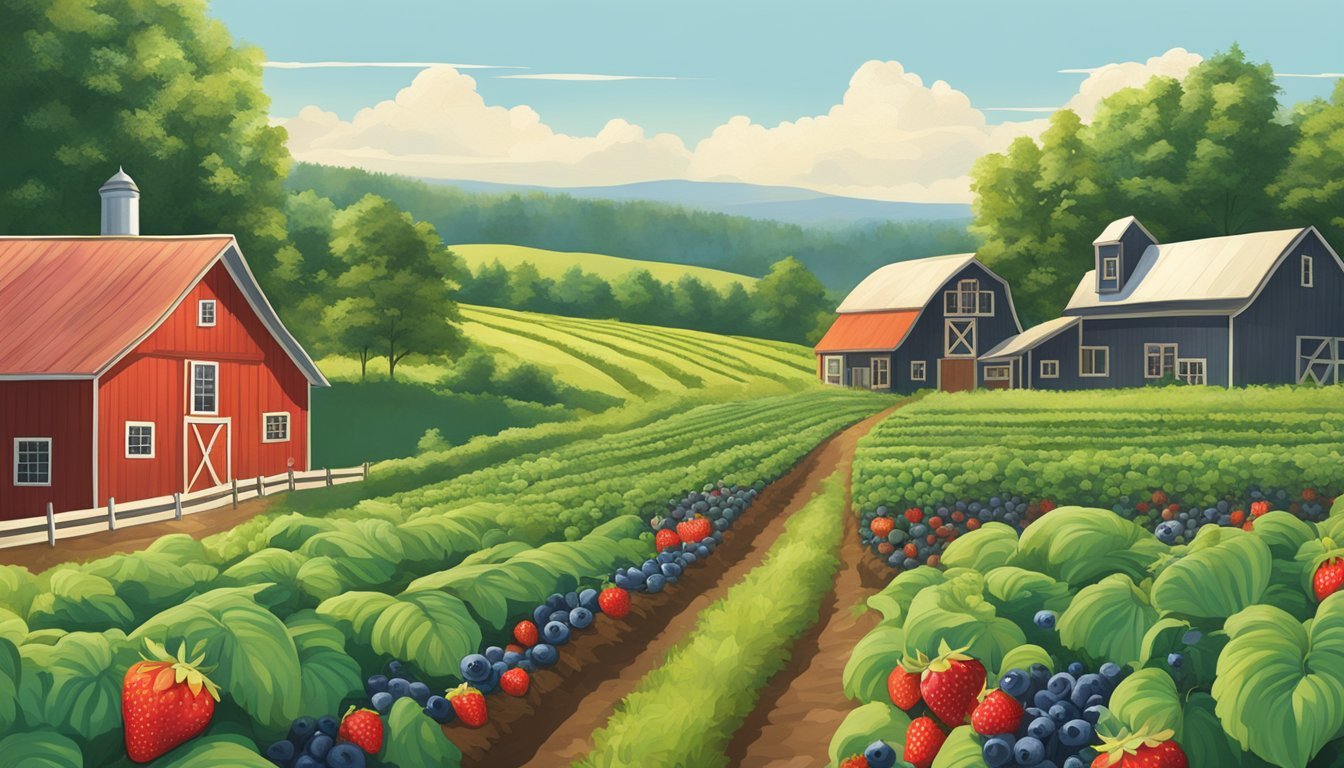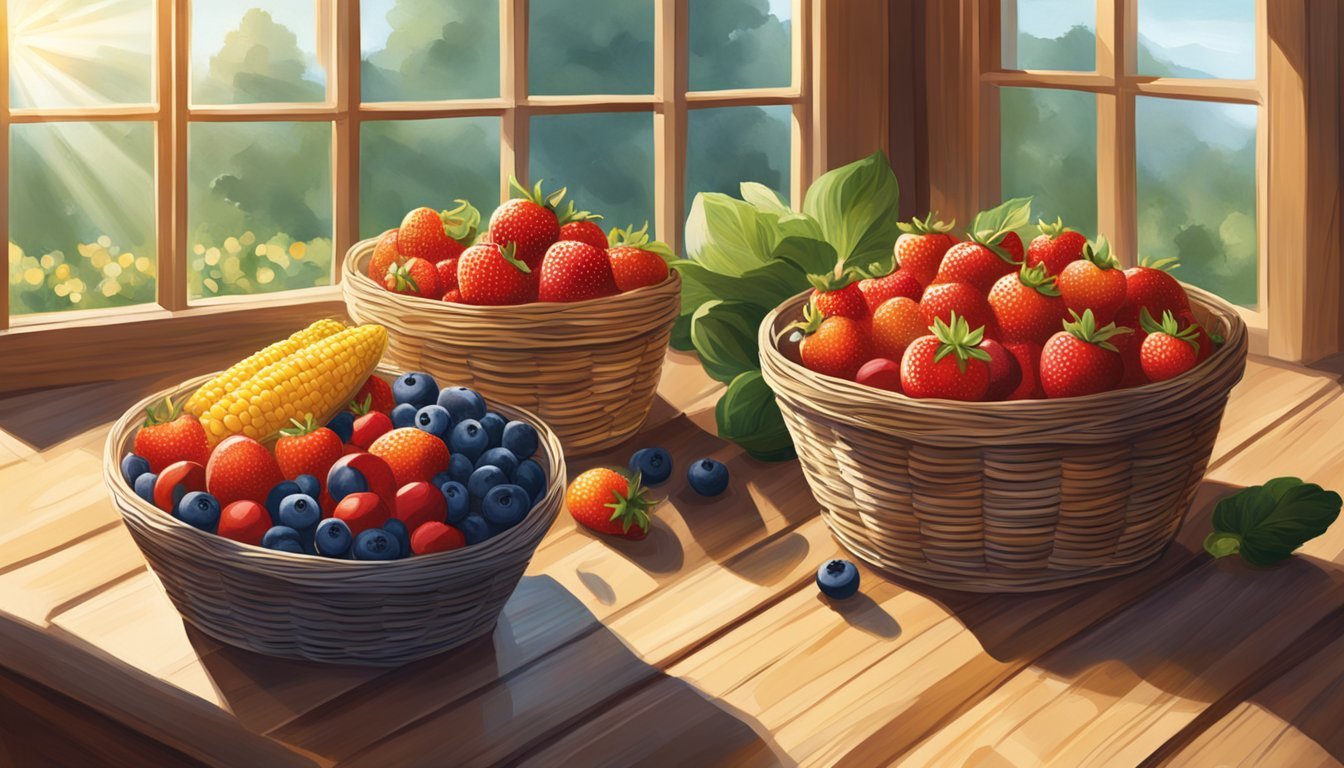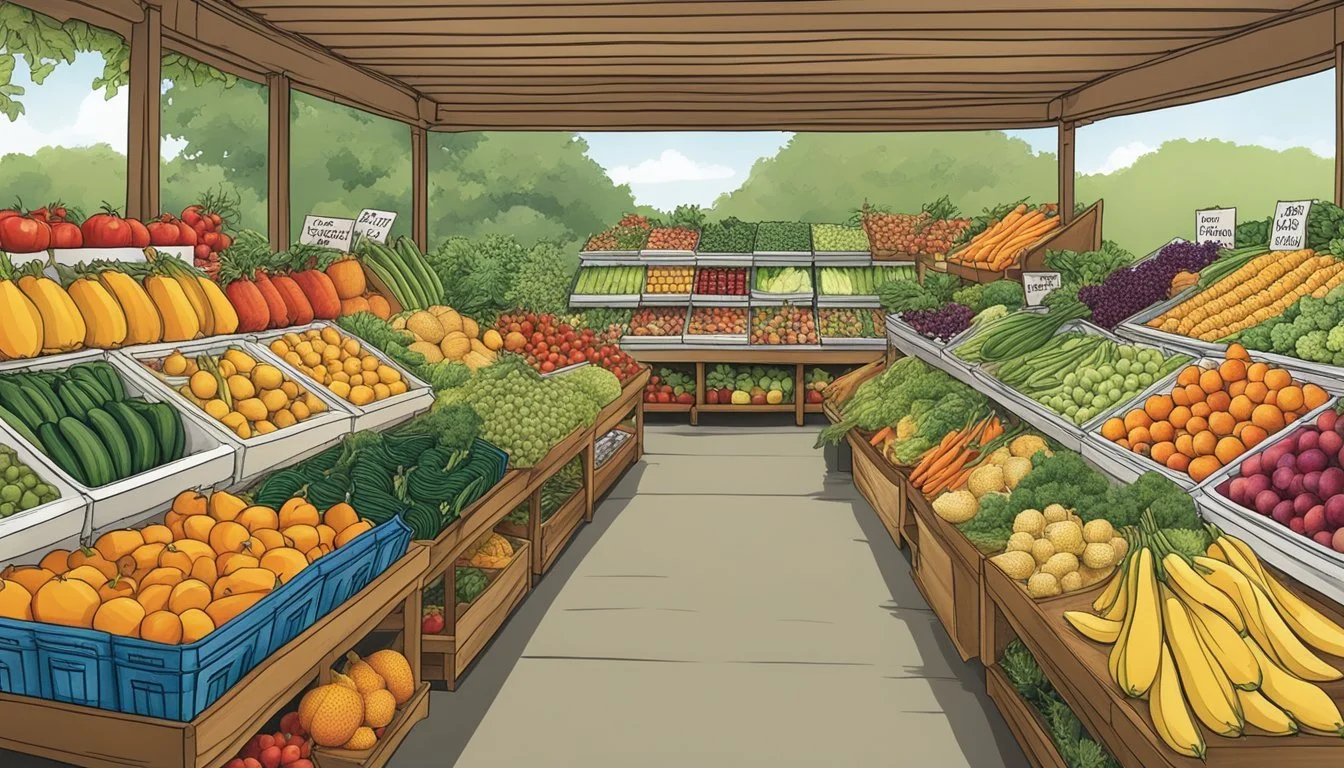Vermont Seasonal Fruit & Vegetables in July
Your Fresh Guide
This Article is Part of our Vermont Seasonal Fruit & Veg Calendar
July in Vermont marks the peak of summer, a time when the region's farms are in full swing and the fields are bustling with activity. This month is synonymous with abundance, bringing a diverse spread of fresh fruits and vegetables to local markets and tables. Vermont's fertile soil and favorable growing conditions during the summer season make it an ideal time for a variety of produce to flourish.
The seasonal bounty in July includes a colorful palette of produce. Ripe berries, such as blueberries (how long do blueberries last?) and raspberries, offer a sweet and tangy flavor, perfect for summer desserts or fresh snacking. Vegetables like beets, carrots, and broccoli are also ready for harvest, contributing to the vibrant greens and reds dotting the local farmers' market stands. The much-anticipated apple starts to make an appearance alongside other summer staples, ensuring that there's a plentiful selection for those seeking the freshest ingredients for their culinary creations.
In sustaining the farm-to-table ethos, Vermonters take pride in the freshness and quality of their local produce. July's in-season fruits and vegetables not only taste better but are also at their nutritional peak. With lower costs and environmental impact due to reduced transportation, the consumption of seasonal produce supports the local economy and promotes a more sustainable food system. Enjoying the season's offerings is not only a treat for the palate but also a celebration of Vermont's agricultural heritage.
Seasonal Overview
July in Vermont is a vibrant month when the shift from spring to summer is evident in the bounty of fruits and vegetables coming to peak availability. Gardens and markets bustle with fresh produce harvested at its most flavorful stage.
Summer Seasonal Shifts
As summer progresses, the variety of available produce expands significantly. Stone fruits and berries become abundant, while the array of fresh vegetables grows. This is a time of transition from the last of the spring crops to the full flush of summer's offering.
July's Harvest Calendar
Fruits:
Blueberries
Raspberries
Blackberries (how long do blackberries last?)
Cherries
Vegetables:
Beets
Cabbage
Carrots
Garlic
Onions
Each item listed is reaching its peak during July, which is indicative of the summer season's generous yield.
Importance of Seasonality
The importance of seasonality in produce cannot be overstated. Eating seasonally ensures consumers enjoy fruits and vegetables at their optimal taste and nutritional value. Moreover, it supports local agriculture and reduces the environmental impact associated with long-distance transportation of food. In July, the focus is on the fresh, locally harvested selections, bringing superior quality to Vermont's tables.
Fruit Highlights
July in Vermont is a month characterized by an abundance of fresh, seasonal fruits. The warmer weather allows for a variety of berries and stone fruits to reach their peak flavor and nutritional value.
Berry Varieties
In July, berries are at their prime in Vermont. Farm stands and markets are bountiful with:
Blueberries: These small, indigo-colored berries are both sweet and tangy. They are perfect for eating fresh or incorporating into desserts and jams.
Raspberries: Recognized for their delicate structure and intense flavor, raspberries can be found in red, black, and purple varieties. They offer a balance of sweetness and slight acidity.
Strawberries: Although the strawberry season starts in June, some varieties continue to be available into early July. These heart-shaped berries are a favorite for their sweetness and juiciness.
Blackberries: These large, plump berries are known for their deep flavor that is both sweet and tart, making them ideal for fresh eating or culinary uses like pies and preserves.
Stone Fruit Selections
July also marks the arrival of stone fruit season, highlighted by:
Peaches: Juicy and fragrant, peaches are a summer favorite. Vermont peaches may be less common than other fruits, but when available, they are a real treat with their fuzzy skin and sweet flesh.
Exotic Fruit Options
While Vermont's climate is not conducive to growing tropical fruits, the following are often found in markets having been brought in from other regions:
Melons: Various types of melons, including cantaloupes (how long does cantaloupe last?) and honeydews, can be enjoyed in July. These melons are known for their hydrating and cooling properties, as well as their sweet and refreshing taste.
Vegetable Highlights
In July, Vermont's soil yields a bounty of vibrant vegetables that span various families, each with their respective attributes of taste, texture, and nutritional value.
Root and Stem Vegetables
Beets: These earthy root vegetables are at their finest in July, presenting a deep red hue and a sweet, slightly tangy flavor. They are versatile, consumed roasted, boiled, or raw in salads.
Potatoes: A staple in many diets, potatoes harvested in July are known for their optimal texture and flavor. They can be prepared in innumerable ways, from baked to mashed or sautéed.
Leafy Greens and Herbs
Greens: The general category of leafy greens, including varieties like kale and spinach, thrives in July. They are known for their rich vitamin content and can be enjoyed raw in salads or cooked in a myriad of dishes.
Nightshade and Squash Families
Tomato: July marks the season for vine-ripened tomatoes, boasting full, rich flavors far superior to off-season varieties. They are a quintessential addition to salads, sandwiches, and sauces.
Peppers: From sweet bell peppers to the zest of hot chilies, peppers harvested in July are particularly flavorful and can be used to enhance both the taste and visual appeal of dishes.
Summer Squash: Including zucchini and yellow squash, this subgroup is in abundance in July. They are known for their tender texture and mild flavor, perfect for sautéing, grilling, or incorporating into baked goods.
Preparing Seasonal Produce
As the summer hits its peak in July, Vermont offers an abundance of fresh fruits and vegetables. This bounty provides an excellent opportunity for preparation and preservation to prolong their use throughout the year, while also exploring various recipes and cooking methods that highlight their peak flavors.
Preservation Techniques
Preserving the freshness of July's seasonal produce ensures that one can enjoy fruits and vegetables beyond their harvest. Here are the main techniques:
Freezing:
Berries: Wash, dry, and spread in a single layer to freeze, then store in freezer bags.
Green Beans: Blanch for three minutes, plunge into ice water, drain, and freeze.
Canning:
Tomatoes: Can be processed into sauces or canned whole.
Cucumbers: Perfect for pickling; consider making dill pickles or bread and butter pickles.
Drying:
Herbs: Tie in bunches and hang in a warm, well-ventilated area away from sunlight.
Peppers: Slice and dry in a dehydrator or low-temperature oven.
Classic Recipes
Julian produce in Vermont inspires a host of classic recipes that celebrate their freshness and taste.
Salsa:
Tomato Salsa: Combine fresh diced tomatoes, onion, cilantro, lime juice, and peppers.
Fruit Salsa: Mix diced peaches or plums with lime juice, honey, and jalapeño.
Soups:
Corn Chowder: Sweet corn is a July favorite for a creamy chowder enriched with potatoes and herbs.
Cold Cucumber Soup: A refreshing blend with yogurt and herbs, served chilled.
Cooking Tips for Peak Flavor
To maximize the flavor of July's produce, apply these simple cooking strategies:
Grilling:
Corn: Grill corn on the cob in husks for a smoky flavor.
Stone Fruit: Halve peaches or plums and grill for a caramelized dessert or salad topping.
Fresh Use:
Berries: Use fresh in salads or desserts to enjoy their natural sweetness.
Green Beans: Lightly steam or sauté to maintain their crispness and bright green color.
Seasoning:
Herbs: Use fresh herbs like basil and cilantro generously to enhance the natural flavors.
Acidity: A splash of vinegar or lemon juice can brighten the taste of any vegetable dish.
Understanding Local Agriculture
Understanding the contours of Vermont's agriculture is essential for comprehending how the state's local farm products, like those available in July, reach the consumer's table with high flavor and nutritional value. Vermont is not only a leading state in the United States for its commitment to local farming but also an exemplar of sustainable agricultural practices.
Vermont's Farming Regions
Vermont is divided into several distinct farming regions, each with its own unique climate and soil conditions conducive to growing a specific range of crops. The Northeast Kingdom, Champlain Valley, and the Southern region are the primary agricultural zones. The Northeast Kingdom is known for its dairy farms and robust apple orchards. The Champlain Valley, blessed with fertile soil and a slightly milder climate, is ideal for a variety of crops, including vegetables, berries, and grains. The Southern region, encompassing areas like the Connecticut River Valley, capitalizes on its longer growing season to produce an array of fruits and vegetables, including the summer harvests.
Agricultural Practices
The farmers of Vermont are known for their sustainable and environmentally friendly farming practices. The state enforces stringent guidelines to ensure that agricultural practices not only provide economic viability but also maintain and enhance the natural resources. Practices such as crop rotation, composting, and the use of integrated pest management (IPM) are common amongst Vermont's farmers. The usage of organic methods is prevalent, with many farms either certified organic or employing organic practices without certification. Farmers also engage in direct-marketing strategies, like community-supported agriculture (CSA), farmers' markets, and farm-to-table connections to sustain local economies and reduce the carbon footprint associated with transportation.
Nutrition and Health
Eating fruits and vegetables in their peak season can provide maximized nutritional benefits. These foods are not only fresher and more flavorful, but their nutrient content is often at its highest when they are harvested in season.
Health Benefits of Seasonal Eating
Freshness: Seasonal fruits and vegetables are typically harvested at the peak of their freshness, making them richer in vitamins and minerals than their off-season counterparts. For instance, July's seasonal produce in Vermont includes nutrient-dense items such as blueberries and spinach, which are high in antioxidants and vitamins.
Nutritional Content: Seasonal eating supports a diet that is diverse and nutrient-rich. The variety of produce available in July—ranging from apples to turnips—offers a wide spectrum of essential nutrients. For example:
Apples: High in fiber, vitamin C, and various antioxidants.
Beets: Good source of fiber, folate, and manganese.
Carrots: Rich in beta-carotene, fiber, vitamin K1, and potassium.
Leafy Greens (such as kale and spinach): Excellent sources of vitamins A, C, and K, as well as minerals like iron and calcium.
Eating these foods raw often retains most of their nutritional value and can contribute to better health. There is a special emphasis placed on integrating raw leafy greens into meals to take advantage of their high vitamin and mineral content.
Health Impact: Consuming a diet abundant in seasonal produce supports overall health. It has been associated with a reduced risk of chronic diseases, such as obesity, diabetes, and heart disease. Raw vegetables like radishes and fresh peas offer crisp textures and flavors alongside their health benefits, encouraging healthier eating patterns.
Incorporating seasonal, locally grown produce into one's diet is a confident step toward nutritional wellbeing and supports the notion that the most beneficial foods for our bodies are those provided by nature at the correct time of year.
Retail and Buying Tips
July presents an abundance of fresh fruits and vegetables in Vermont, offering the perfect opportunity for consumers to purchase peak-season produce. This section guides shoppers on how to select quality items at the market and ensure they are getting the best possible flavors and nutritional value.
Selecting Quality Produce
When selecting fruits and vegetables, shoppers should seek out produce with a bright, natural color—a good indicator that the item is ripe and ready to eat. It is crucial to inspect the stem area of fruits like tomatoes and peppers; a fresh, green stem suggests a recent harvest. For items sold in bunches, such as greens or herbs, crisp leaves without signs of wilting denote freshness.
In terms of fruit, one should look for firmness that gives slightly under pressure, signaling that the fruit is at its peak ripeness. Bananas should be uniformly yellow, and stone fruits like peaches should emit a sweet fragrance. Berries should be firm and free from moisture, which can lead to rapid decay.
What to Look for at the Market
At the market, it's recommended to start in the produce section. Here, buyers can take advantage of the following:
Seasonal Availability Table: This provides a quick reference to what is in season during July in Vermont such as strawberries, blueberries, and raspberries.
Locally Grown Labels: These indicate the produce has been sourced from nearby farms, ensuring freshness and supporting local agriculture.
Buyers are advised to store their newly purchased fruits at room temperature on the counter to preserve flavor, except for berries, which should be refrigerated. Vegetables like lettuce and greens benefit from refrigeration to maintain crispness. Avoid placing produce in airtight bags or containers as this can accelerate spoilage.
By focusing on these details, one can ensure they are choosing the freshest and most flavorful produce while shopping in Vermont during July.
Additional Resources
This section provides relevant resources for those seeking more comprehensive knowledge about Vermont's local produce and opportunities to engage with the community during the lush month of July.
Further Reading
Vermont Harvest Calendar: Provides a detailed month-by-month breakdown of what fruits and vegetables are in season.
Farm to Table Networks: Numerous books and websites offer insight into Vermont's farm-to-table movement, emphasizing local produce and sustainable agriculture.
Community Events
Farmers Markets: These are prime spots to find the freshest July produce, directly from local growers. Events are typically listed in community calendars and local bulletins.
"Farm to Family Coupon" Program: Offers financial resources to help Vermonters access locally grown produce. It connects the community with healthy food options.
Conclusion
In Vermont, July is a bountiful month for a variety of fresh and local produce. The warm summer climate supports a flush of both fruit and vegetables that appeal to the discerning consumer and the farm-to-table advocate. The following tables summarize the elements of July's harvest.
Fruit:
Apples*
Raspberries*
Blueberries*
Blackberries*
Vegetables:
Beans*
Beets*
Broccoli
Carrots*
Cauliflower*
Greens
Kale*
Peas
Potatoes*
Radishes
Summer Squash*
Tomatoes*
Turnips*
Items marked with an asterisk (*) are particularly abundant in July, indicating peak seasonality. This is the prime time for these selections to be incorporated into local cuisine, providing a spectre of flavor and nutrition.
Community-supported agriculture flourishes with such varieties. Vermont residents can indulge in these fresh options from farmers markets, local produce stands, and even their backyard gardens. The abundance aligns with sustainable practices and supports the local economy, emphasizing the importance of eating seasonally and locally.
For chefs and home cooks, this cornucopia offers ample room for culinary exploration. From savory summer squash dishes to sweet berry pies, July's harvest in Vermont is a canvas for gastronomic creativity, supporting a diet that's as rich in flavor as it is in health benefits.











